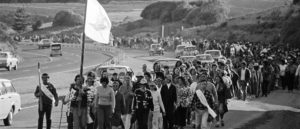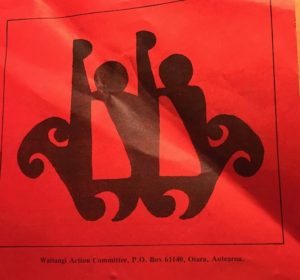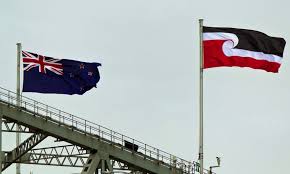The Māori Flag – a Symbol of Liberation and Identity
“Me tupu i a wīwī me tupu i a wāwā, turia ki te wera, me piri tonu ki te korito o te rengarenga, me whakapakari ki te hua o te kawariki” Māori Marsden .
(Flourish in many places as you face the fires of adversity; cling to the heart of the rengarenga as sustenance for your soul, and to harden you for all that lies ahead of you; be like the fruit of the kawariki, small in size, large in deed, and ready to flourish in the most adverse of conditions).
There were many icons of resistance in Aotearoa during the 1970s- Ngā Tamatoa, the pou kara of the Māori Land March 1975, the Bastion Point Noho Whenua flag 1977-1978 , the Waitangi Action Committee flag 1978-1985, the Kotahitanga flag 1984.





In 1981, we saw the Aboriginal flag in Brisbane pre the Commonwealth Games- an indigenous symbol that called out to the people. “Land Rights NOW!” .. “200,000 years of dreaming, 200 years of nightmares. “ Sprinter Cathy Freeman later ignited international pride re her victory lap with the Aboriginal flag after winning double gold at 1994 Commonwealth games.
Sprinter Cathy Freeman later ignited international pride re her victory lap with the Aboriginal flag after winning double gold at 1994 Commonwealth games.

The idea of a national Māori flag was borrowed from the Aboriginal flag. 1989 in the lead up to the 150th commemoration of the Treaty signing- a national hui of Māori activists considered several campaigns to bring awareness to the plight of the Treaty of Waitangi and ongoing legislative abuses to Māori. The Crown had millions of dollars to promote a wonderful co-existence with the Treaty Partner. Māori activists under the mantle of Te Kotahitanga or The Movement -had no putea.
Getting arrested was time consuming and is to be saved for special occasions. The Movement wanted to use their creative talents to promote awareness of ongoing Treaty grievances.
Ngāti Kahungunu & Ngāpuhi activists promoted kaupapa music- waiata reo Māori. Tuhoe began an awareness campaign to reclaim their whenua and created their own kara. Others went into storytelling through contemporary art. Far North group Te Kawariki embarked on a campaign to set up a Māori flag competition to inspire Māori to have hope in a time- where Māori were struggling to realise kaupapa Māori education, land claims and high unemployment. Te Kawariki sought a flag that would appeal to Māori of any politics or religion- a flag of Māori identity and pride.
The final winning Māori flag now commonly referred to as the Tino or Tino Rangatiratanga flag was created by 3 women from Tai Tokerau: the late Hiraina Marsden(Ngai Takoto), the late Jan Dobson Smith (Patu Harakeke) and Linda Munn (Ngāti Manu, Tauranga Moana). Liz Marsden (Ngai Takoto, Ngāti Korokoro) suggested the koru be off centre. The flag was taken to several hui in Tai Tokerau, the design was modified a few times, Ahipara women hand sewed some flags and launched them in Kaitaia on the annual hikoi to Waitangi in 1990.
Reddish brown represents Papatuānuku- the earth mother. The white represents Te Ao Marama and the koru reminds us that life is continually in renewal and ongoing. Black represents Ranginui- the sky father. No matter what, there is a natural order in the universe- the earth and sky embrace the world of the living. The natural colours and its simplistic depiction of the world led to an early acceptance of the flag by many MĀORI in different walks of life.
The simple symbolism and a $5 promotional poster was circulated around the country and was scripted by Walter Erstich. “The elements of the national Māori flag represent the three realms:
- Te Korekore, potential being (black, top)
- Te Ao Mārama, the realm of being and light (white, centre).The koru is symbolic of a curling fern frond, representing the unfolding of new life, hope for the future and the process of renewal.
- Te Whai Ao, coming into being (red, bottom).”
Te Kawariki members did try and control the sale of quality flags- but so many flags were given as koha for hikoi, land occupations, Xmas presents for the cousins in Australia- it became, aroha mai, unprofitable. After the death of Jan Dobson, Te Kawariki did not have the capacity to sell and distribute the flag.
Whānau did like buying the cheaper $10 versions from the $2 shops and it solved the problem of access and affordability . However, be wary of some kara versions that have a narrow white strip which alter the flag dimensions.
After much consultation Te Kawariki set a kaupapa with the flag:
1) the flag dimensions not be changed;
2) the kara should not be worn on the kotore ( derriere, bottom);
3) the icon be used by any group supporting and promoting kaupapa Māori and not for personal gain;
4) the original artists wanted any royalties to go towards setting up a Māori arts wānanga in Ngāpuhi;
2009 –Pita Sharples, “Minister of Māori Affairs publicly called for a Māori flag to be flown from the Auckland Harbour Bridge on Waitangi Day. He considered that flying a Māori flag at sites of national significance would reflect and enhance Crown-Māori relationships. The Prime Minister answered that call, saying that he would support flying the two flags together, if agreement could be reached on a preferred flag”.
Te Puni Kokiri hosted 21 public hui throughout the motu to ascertain which kara could serve Māori. All hui recognised other flags which meant significant things to hapu, Iwi and the nation. Each marae has the mana to fly its own flags. In Australia- the Aboriginal flag is flown at state events- as the government has invested in two flagpoles.
“Over 1,200 submissions were received, with 79% of submitters identifying themselves as Māori. Of the total submissions, 80.1% selected the Māori (Tino Rangatiratanga) flag as the preferred national Māori flag.On 14 December 2009, Cabinet recognised the Māori (Tino Rangatiratanga) flag (pictured) as the preferred national Māori flag, and noted that it will complement the New Zealand flag.”
Te Kawariki advised Dr Pita Sharples to let the government know that although the kara is recognised as a national Māori flag- the ownership of the Māori flag remains with Māori people-not with the State. The government could pass a law and extinguish it overnight.
As a Ngāti Whātua leader reminded the public forum at Waitangi,” if you say the Kara belongs to all of us Māori – ka pai. If it belongs to a small group- keep it. “
2010 – 6th Feb, the Māori flag was handed over to rangatahi Māori as the next generation of kaitiaki.
2015, the government conducted a referendum regarding replacing the union jack flag. The 3 whānau of the flag designers decided not to enter the Tino flag as a new flag for Aotearoa. It was felt that the Māori flag would not get the majority support of Aotearoa.
July 2015, The kara is not owned by any one political party or faith- mā tātou katoa. “The Tino flag has its own mana, identity and national recognition amongst many Māori. Papatuanuku (red), Ranginui (black) and the koru of Te Ao Marama (white) remind us of our responsibilities to our taiao and simple enduring values from our past to guide our rangatahi and future mokopuna. The Tino flag is not owned by the State, it is a taonga Māori and is not to be vetted by others who mock Māori sovereignty. Māori are comfortable with the tino flag- which is a modest statement of Māori identity and is not separatist nor a criticism of anyone else. Aotearoa is not ready for Tino, for Māori landlords, it’s not even ready to replace the union jack. ” MANA News 2015
2017 The whānau of the flag designers will be meeting to discuss the intellectual property rights …
2018– update the history of the Tino flag for mokopuna.
2019– We heard concerns regarding the lease of the Aboriginal flag copyright by the artist to a non Indigenous company Flags – which has forbidden the use of the Aboriginal flag to Aboriginal people and indigenous games without financial permission. Let us hope we never go there. It has been disastrous for Aboriginal people.
Since 1990 ..Debate re He Whakaputanga and Tino flags.
Both flags have their own mana and have arisen as a response from important sequences of events in 1830s and the latter in the late 1980s.
Te Kara o Te Whakaminenga o Nga Hapu o Nu Tireni is the original 1834 New Zealand flag used primarily by Ngāpuhi entrepreneurs for international trading purposes .
He Wakaputanga o Te Rangatiratanga o Nu Tireni also known as The Declaration of Independence 1835 is a proclamation of absolute sovereignty by chiefs and hapu to external countries who were showing interest in colonising New Zealand at the time.
He Wakaputanga has been hidden from history books of Aotearoa for 188 years- convenient amnesia. The Waitangi Tribunal in 2014 acknowledged that Ngāpuhi did not cede sovereignty as only Te Tiriti Māori was signed in the north. How that acknowledgement translates into practical reality is part of an ongoing discussion within Ngāpuhi.
Principles of flying the national Māori flag with other flags – side by side. Not one under the other.



H Halkyard-Harawira , For Te Kawariki a group of Tiriti activists from the Far North Tai Tokerau 1985—




